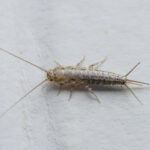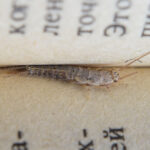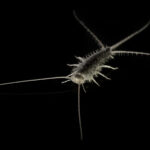How Can We Help?
What are some common hiding spots for silverfish in homes?
Silverfish are sneaky insects that love dark, damp spots, making certain areas of homes super appealing to them. They often hide in basements, bathrooms, and kitchens because of the high humidity levels. In basements, you  might find cracks and crevices in walls or floors or in stored boxes and other clutter where moisture builds up. Bathrooms are perfect for them with all the moisture from showers and sinks; they can be found behind baseboards, under sinks, and within cabinets. Kitchens are also attractive due to water sources and food. They often hide under sinks, behind appliances, and inside cupboards where food particles might be present.
might find cracks and crevices in walls or floors or in stored boxes and other clutter where moisture builds up. Bathrooms are perfect for them with all the moisture from showers and sinks; they can be found behind baseboards, under sinks, and within cabinets. Kitchens are also attractive due to water sources and food. They often hide under sinks, behind appliances, and inside cupboards where food particles might be present.
Silverfish are also drawn to areas with paper, glue, and fabric, which they like to munch on. So, attics and closets with books, old papers, cardboard boxes, and clothing can become infested. They also hide in wall voids, around plumbing fixtures, and in insulation, using any small openings to stay hidden. Sometimes, you'll find them behind wallpaper and in the seams, where the glue is a food source. In bedrooms, they might hide under beds, in the folds of linens, and within piles of laundry. Their nighttime habits help them stay under the radar as they search for food and water at night.
How do silverfish get into homes in the first place?
Silverfish often sneak into homes through small openings, looking for cozy spots. These nimble critters usually find their way in through gaps and cracks in the foundation, spaces around windows and doors, and poorly sealed utility pipes. They can also get a ride on infested items like cardboard boxes, books, and furniture, especially if these have been stored in damp, dark places like basements or storage units. Silverfish are pretty good climbers and can slip through tiny gaps, so even small openings can be entry points.
Homes with high humidity levels are particularly inviting to silverfish since they thrive in moist environments. Leaky pipes and poorly ventilated bathrooms, basements, and kitchens provide the moisture they need. These bugs often head indoors during heavy rain or extreme weather, seeking more stable and comfy spots.
Outdoor factors like piles of leaves, mulch, and overgrown plants near the foundation can attract silverfish, which then make their way inside in search of food and shelter.
How do you find where silverfish are nesting or breeding in a home?
To find where silverfish are nesting or breeding in your home, focus on the dark, damp spots they love. Start by checking basements, bathrooms, and kitchens since these areas usually have higher humidity. Look for signs like tiny pepper-like droppings, yellowish stains, scales, or damaged items like books, paper, and fabrics. Pay close attention to cracks and crevices in walls and floors, as well as behind baseboards, under sinks, and around plumbing fixtures.
In basements, check storage boxes, especially those with papers or old clothes, and inspect any insulation for signs
Bedrooms and attics can also be nesting sites, particularly where books, papers, and clothing are stored. Inspect closets, under beds, and within piles of laundry for signs of silverfish. Also, check for any gaps or openings in walls, around windows, and doors that might serve as entry points.
Using sticky traps can help pinpoint high-activity areas. Place these traps in suspected locations to catch silverfish, which can indicate their nesting spots. Once you find their hiding places, reducing moisture, sealing entry points, and decluttering will help eliminate and prevent more infestations.
Can silverfish infestations spread from one room to other areas of a home?
Yes, silverfish infestations can easily spread from one room to other parts of a home because they can move through small cracks and crevices effortlessly. These nimble insects are nocturnal and can travel quite far in search of food and a cozy living spot. If your home has multiple areas with the dark, damp, and humid conditions they love, silverfish will explore and set up new nests beyond the initial infested area.
Silverfish munch on all sorts of stuff, which are scattered throughout most homes. As they hunt for these snacks, they can move from one room to another, spreading the infestation. For example, they might start in a bathroom 
Clutter and poor storage can also help them spread. Infested items like boxes of books or old clothes can be moved from one room to another, unknowingly spreading these pests. To stop the spread of a silverfish infestation, it's crucial to fix moisture issues, seal entry points, and keep a clean, clutter-free home. Frequent inspections by professionals like us here at Youngs Pest Control can help identify and eliminate any potential infestations before they spread.
